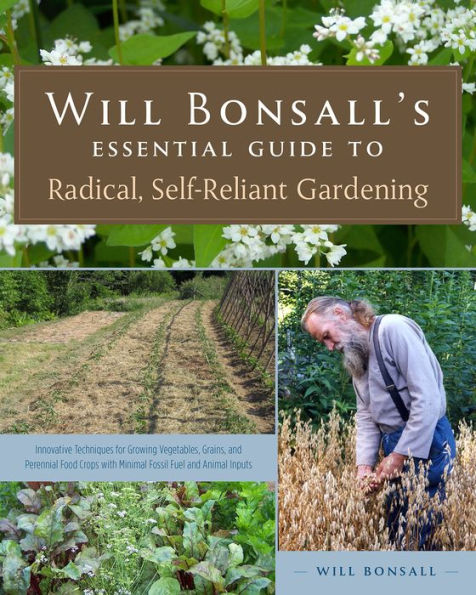Publishers Weekly-
"Homesteader, organic farmer, and visionary Bonsall offers a thorough, albeit apocalyptic, farming guide to surviving the current times and, if need be, the end times. The title is misleading; the book is not so much a gardening guide as a set of survival instructions, and not for the casual gardener. Drawing on 40 years of personal experience growing his own food, Bonsall emphasizes three principles: economic exigency that requires making do; planning to survive a future catastrophe; and transforming civilization. To this end, the book focuses on staple foods, including grains, dried legumes, and oilseeds, as well as the usual greens and root crops, while discussing such fundamentals as assessing soil fertility, composting, using manure (including human), mulching, grafting, pollinating, seed saving, milling, malting, freezing and fermenting. The book will not suit everyone, but those who share Bonsall’s vision will be well served and firmly grounded. Over 200 full-color photos.”
“Every gardener and small farmer can benefit from Will Bonsall's decades of focused, quality experience. Will's book is one of the key practical resources you should read—as you reach for full sustainable soil fertility in your garden or farm!”—John Jeavons, author, executive director of Ecology Action, and developer of sustainable biointensive mini-farming
"Will Bonsall’s homestead is a 'thinking farm,' not one engaged in armchair musings about agriculture, but where difficult questions are addressed by intense experimentation. This book pairs the incredible depth of Bonsall’s gardening knowledge with his infectious enthusiasm. It is both a magnificent reference and an inspiring call to action. Every practical lesson throughout is guided by the vision that our humble gardens can affect the world."—Steve Conaway, Conservation and Outreach Director at Greenwich (CT) Land Trust
“Every gardener and small farmer can benefit from Will Bonsall's decades of focused, quality experience. Will's book is one of the key practical resources you should read—as you reach for full sustainable soil fertility in your garden or farm!”—John Jeavons, author and developer of sustainable biologically intensive food-growing
“Here is a bright star in the constellation of voices for land-based sustainability. Not only is Will Bonsall incredibly learned – the result of decades of careful studies in the field and out – he is bawdy and brave and bold. His credibility is a Ph.D. in homesteading and his rambunctious wisdom is very worth reading. If you want to learn from a master, you need this book.”—Janisse Ray, author of The Seed Underground
"The risk of describing Will Bonsall’s Essential Guide to Radical, Self-Reliant Gardening as a gardening book is that the aspiring reader may miss the reality that it is really a book on life, centered as a good life should be, around a garden.
Will is a patient teacher with encyclopedic knowledge. His writing style is warm and authentic, accentuated by his dry New England humor. To read this book is akin to having Will stop by and visit by the glowing kitchen cookstove. He shares a lifetime of observations and conclusions – both useful and essential – and a deep respect for those who have come before us."—Jim Gerritsen, certified organic seed potato grower and owner of Wood Prairie Farm
"Will Bonsall—Mr. Scatterseed himself—has done it all, and this book covers it all, from maintaining soil fertility with minimal external inputs to growing annual and perennial vegetables, fruit, nuts, grain, beans, and even oilseed crops. Will’s methods are all vegan based and garden scale, with little resort to tools beyond hand tools and a rototiller and shredder. His description of making oil-seed seed meals and cooking with them is particularly interesting.
Will’s book is a great introduction to gardening for the beginner, and it also offers enough brand new original material to delight even the most expert. Best of all, the interweaving of Will’s coherent personal philosophy, decades of gardening experience, down-to-earth style, and touches of humor all make for an interesting, entertaining read."—Carol Deppe, author of The Tao of Vegetable Gardening and The Resilient Gardener
"Eco-efficiency is the key new word and gardens-without-borders is the key new concept with which Will Bonsall illuminates 'this experiment we call civilization.' His view is wide and deep. You can accept his warm, witty invitation to explore the big questions. Or/and you can, with grace and ease, pluck out practical, hands-on directions as needed for all aspects of cyclical food production and use. I will read it again and again for reference, guidance, inspiration, and delight."—Eva Sommaripa, pioneering organic farmer at Eva's Garden in Dartmouth, Massachusetts, and the hero of Wild Flavors by Didi Emmons
"If you wish to live well and eat well no matter what is going on in the rest of the world, this book is for you. Thresh your own grain and press your own oil. Can't buy seeds, no problem. Can't buy fertilizer, no problem. Will Bonsall will help you enjoy the good life under any and all conditions."—Eliot Coleman, author of The New Organic Grower and The Winter Harvest Handbook



